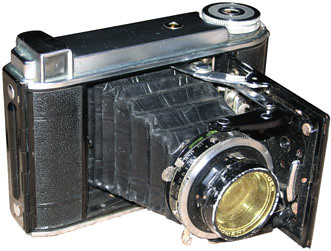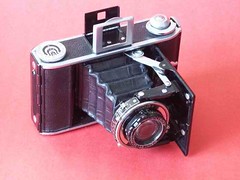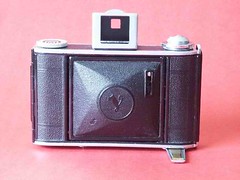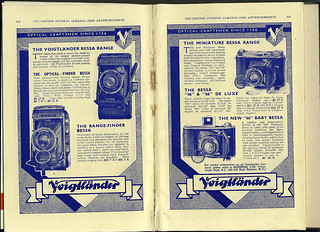Difference between revisions of "Bessa 66"
Hanskerensky (talk | contribs) m (Bessa 466 now in bold) |
|||
| (26 intermediate revisions by 2 users not shown) | |||
| Line 1: | Line 1: | ||
| − | |||
{|class=floatleft | {|class=floatleft | ||
{{Flickr_image | {{Flickr_image | ||
| Line 5: | Line 4: | ||
|image= http://farm3.static.flickr.com/2065/2319108893_b43a9431d9.jpg | |image= http://farm3.static.flickr.com/2065/2319108893_b43a9431d9.jpg | ||
|image_align= left | |image_align= left | ||
| − | |image_text= Voigtländer Bessa 66 ( | + | |image_text= Voigtländer Bessa 66 (deluxe model) |
|image_by= AWCam | |image_by= AWCam | ||
|image_rights= with permission | |image_rights= with permission | ||
}} | }} | ||
|} | |} | ||
| − | The '''Bessa 66''' is a [[folding]] [[120 film|120 rollfilm]] camera made in Germany by [[Voigtländer]], introduced in 1938 | + | The '''Bessa 66''' is a [[folding]] [[120 film|120 rollfilm]] camera made in Germany by [[Voigtländer]], it was introduced in 1938 as a 6x6 image camera. After the war Voigtländer retook production between 1948-1950, when it was replaced by the [[Perkeo]] . The Bessa 66 was one in a long series of [[Bessa]] cameras, this camera and the [[Bessa 46]] are sometimes called "'''Baby-Bessa'''" or "'''Klein-Bessa'''", due to their compact design and because most of the Bessas until then were of 6x9 format. <ref>{{McKeown12}} Page 953.</ref> Both cameras fit comfortably in a coat pocket, and are just slightly larger than the 35mm [[Vito]]. |
| + | |||
| + | There were two versions, the first was later called Deluxe model with an optical viewfinder (inverted telescope), and the standard with an Albada or Frame viewfinder, and a different top-plate.<br> | ||
| + | The optical viewfinder version called Small-Bessa version came first (1938), with the same top-plate as the more expensive 6x9 [[Bessa]] with film counter and double-exposure prevention. The automatic film stop has to be released with a slide in the back plate before advancing film and the film counter must be manually reset with a slide on the front plate. <br> | ||
| + | By 1939 a cheaper and simpler version came out without the frame counter or double-exposure prevention and a simpler viewfinder (Albada or frame), and these were called "'''Baby-Bessa'''".<br> | ||
| + | A special version called '''Bessa 466''' that could be switched between 6x4.5 and 6x6 was produced in very small quantities (less than 500).<br> | ||
| + | Postwar examples had the sports finder only and can be recognized by different lens styling. | ||
| + | |||
| + | Several different lenses and shutters were used through the production of the camera, and a yellow 'Moment' filter (30mm push-in filter<ref>Moment filters are similar in diameter to [[Series_filters|Series V]] filters, but Moment are thinner (2.75mm).</ref>) was fitted to the front of the lens, which hinged out of the way when not required in pre-war models. <ref>[http://www.schoebels-voigtlaender-archiv.de/Bild0104.html In-depth list] of all the variants at Schoebel's Voigtlander-Archive (in German) ]</ref>. The camera has zone focusing markings, a triangle at 3.3m (11 ft) for snapshots and a circle at 10m (33 ft) for landscape. It is recommended that the lens is stopped down to at least f/5.6, and that subjects at 8-16 feet (2.5-5m) are zone-focused using the triangle, while those further than 16 feet (5m-infinity) are zone-focused using the circle. A depth of field scale is provided, on top for the standard and at the bottom for the deluxe models. After the war the lens styling changed, and shutters with flash sync were observed. | ||
| − | + | The shutter release is a lever that protrudes from the lens door, it retracts when the door is closed. Film advance is with a wheel on the top plate; in the Deluxe models, the film counter and double-exposure prevention make the process more involved <ref>[https://www.butkus.org/chinon/voigtlander_pdf/voigtlander_baby_bessa_66/voigtlander_baby_66.pdf advancing film in the Bessa 66] at Mike Butkus' Orphan Camera manuals</ref> . | |
| − | + | There is a rotating foot at the bottom which has a double purpose, it locks the film door or is used to stabilize the camera on table-top. | |
| − | |||
| − | |||
{{br}} | {{br}} | ||
| Line 38: | Line 43: | ||
* Country of origin: Germany | * Country of origin: Germany | ||
* Manufacturer: [[Voigtländer]] | * Manufacturer: [[Voigtländer]] | ||
| − | * In production: 1938 | + | * In production: 1938~1940, 1948-50 |
* Film: twelve 6×6cm exposures on [[120 film]] | * Film: twelve 6×6cm exposures on [[120 film]] | ||
| − | * Lens: | + | * Lens: Voigtar 75mm f/3.5, Vaskar 75mm f/4.5 (Post-war), Skopar or Color-Skopar (Post-War) 75mm f/3.5, or [[Heliar|Color Heliar]] 75mm f/3.5 |
| − | * Viewfinder: Sports finder and optical-viewfinder in "Deluxe" models | + | * Viewfinder: Sports finder in most models, and optical-viewfinder in "Deluxe" models |
* Shutters observed: | * Shutters observed: | ||
| − | ** [[Compur]], | + | ** [[Compur]], T, B, 1, 2, 5, 10, 25, 50, 100, 300 |
| − | ** [[Compur-Rapid]], | + | ** [[Compur-Rapid]], T, B, 1, 2, 5, 10, 25, 50, 100, 250, 500 |
| − | ** [[Prontor]] II, | + | ** [[Prontor]] II, T, B, 1, 2, 5, 10, 25, 50, 100, 175 |
| − | * Dimensions: 128 × 89 × 97mm (41mm folded); weight 510g | + | * Dimensions: 128 × 89 × 97mm (41mm folded); weight 510g (Deluxe) and 460g (Standard) |
==Notes== | ==Notes== | ||
| Line 52: | Line 57: | ||
== Links == | == Links == | ||
| − | * [http://www.cosmonet.org/camera/bessa66_e.html Bessa 66] at [http://www.cosmonet.org/camera/index_e.html The Classic Camera] | + | * [https://web.archive.org/web/20170609114624/http://www.cosmonet.org/camera/bessa66_e.html Bessa 66] at [https://web.archive.org/web/20170609131749/http://www.cosmonet.org/camera/index_e.html The Classic Camera] (archived) |
* [http://mgroleau.com/photo/allemagne/voigtlander/voigt_bessa_66.html Bessa 66] at [http://mgroleau.com/photo/index.html M. Groleau's site] (in French) | * [http://mgroleau.com/photo/allemagne/voigtlander/voigt_bessa_66.html Bessa 66] at [http://mgroleau.com/photo/index.html M. Groleau's site] (in French) | ||
* [https://internoinbakelite.wordpress.com/2015/03/03/initials-bb-baby-bessa/ Voigtlander Bessa 66] on [https://internoinbakelite.wordpress.com/2015/03/03/initials-bb-baby-bessa/ Interno in bakelite] (italian) | * [https://internoinbakelite.wordpress.com/2015/03/03/initials-bb-baby-bessa/ Voigtlander Bessa 66] on [https://internoinbakelite.wordpress.com/2015/03/03/initials-bb-baby-bessa/ Interno in bakelite] (italian) | ||
| Line 58: | Line 63: | ||
* [http://www.cameramanuals.org/voigtlander_pdf/voigtlander_klein-bessa-german.pdf German PDF-manual] on M. Butkus' site. | * [http://www.cameramanuals.org/voigtlander_pdf/voigtlander_klein-bessa-german.pdf German PDF-manual] on M. Butkus' site. | ||
| − | [[Category: B | + | |
| + | {|class=floatleft | ||
| + | | | ||
| + | {{Flickr_image | ||
| + | |image_source=https://www.flickr.com/photos/95742794@N05/30999546760/in/pool-camerawiki | ||
| + | |image=https://live.staticflickr.com/5658/30999546760_18fb61df2b_n.jpg | ||
| + | |image_align= | ||
| + | |image_text=Besa 66 Deluxe <br> with Heliar and Compur-Rapid | ||
| + | |image_by= Jörg Krüger | ||
| + | |image_rights= with permission | ||
| + | }} | ||
| + | | | ||
| + | {{Flickr_image | ||
| + | |image_source=https://www.flickr.com/photos/raulm/5143883501/in/pool-camerawiki | ||
| + | |image=https://live.staticflickr.com/1378/5143883501_33924633ec_n.jpg | ||
| + | |image_align= | ||
| + | |image_text=Besa 66 Deluxe back <br> Film counter | ||
| + | |image_by= Raúl Sá Dantas | ||
| + | |image_rights= with permission | ||
| + | }} | ||
| + | |- | ||
| + | | | ||
| + | {{Flickr_image | ||
| + | |image_source=https://www.flickr.com/photos/thorpehamlet/10570482226/in/pool-camerawiki | ||
| + | |image= http://farm6.staticflickr.com/5482/10570482226_5a647ff032_n.jpg | ||
| + | |image_align= | ||
| + | |image_text= [[Voigtländer]] Bessa models for [[120 film]] rolls. <br> Ad in The British Journal Photographic Almanac 1939<br> | ||
| + | |scan_by= John-Henry Collinson | ||
| + | |image_rights= wp | ||
| + | }} | ||
| + | |} | ||
| + | |||
| + | [[Category: B]] | ||
[[Category: German 6x6 viewfinder folding]] | [[Category: German 6x6 viewfinder folding]] | ||
| − | [[Category: Voigtländer | + | [[Category: Voigtländer]] |
| + | [[Category:120 film]] | ||
| + | [[Category: 1939]] | ||
Latest revision as of 04:46, 20 September 2023

|
| Voigtländer Bessa 66 (deluxe model) image by AWCam (Image rights) |
The Bessa 66 is a folding 120 rollfilm camera made in Germany by Voigtländer, it was introduced in 1938 as a 6x6 image camera. After the war Voigtländer retook production between 1948-1950, when it was replaced by the Perkeo . The Bessa 66 was one in a long series of Bessa cameras, this camera and the Bessa 46 are sometimes called "Baby-Bessa" or "Klein-Bessa", due to their compact design and because most of the Bessas until then were of 6x9 format. [1] Both cameras fit comfortably in a coat pocket, and are just slightly larger than the 35mm Vito.
There were two versions, the first was later called Deluxe model with an optical viewfinder (inverted telescope), and the standard with an Albada or Frame viewfinder, and a different top-plate.
The optical viewfinder version called Small-Bessa version came first (1938), with the same top-plate as the more expensive 6x9 Bessa with film counter and double-exposure prevention. The automatic film stop has to be released with a slide in the back plate before advancing film and the film counter must be manually reset with a slide on the front plate.
By 1939 a cheaper and simpler version came out without the frame counter or double-exposure prevention and a simpler viewfinder (Albada or frame), and these were called "Baby-Bessa".
A special version called Bessa 466 that could be switched between 6x4.5 and 6x6 was produced in very small quantities (less than 500).
Postwar examples had the sports finder only and can be recognized by different lens styling.
Several different lenses and shutters were used through the production of the camera, and a yellow 'Moment' filter (30mm push-in filter[2]) was fitted to the front of the lens, which hinged out of the way when not required in pre-war models. [3]. The camera has zone focusing markings, a triangle at 3.3m (11 ft) for snapshots and a circle at 10m (33 ft) for landscape. It is recommended that the lens is stopped down to at least f/5.6, and that subjects at 8-16 feet (2.5-5m) are zone-focused using the triangle, while those further than 16 feet (5m-infinity) are zone-focused using the circle. A depth of field scale is provided, on top for the standard and at the bottom for the deluxe models. After the war the lens styling changed, and shutters with flash sync were observed.
The shutter release is a lever that protrudes from the lens door, it retracts when the door is closed. Film advance is with a wheel on the top plate; in the Deluxe models, the film counter and double-exposure prevention make the process more involved [4] . There is a rotating foot at the bottom which has a double purpose, it locks the film door or is used to stabilize the camera on table-top.

|

|

|

|

|

|
| Bessa 66 "standard" Images by Mario Groleau. (Image rights) |
Specifications
- Country of origin: Germany
- Manufacturer: Voigtländer
- In production: 1938~1940, 1948-50
- Film: twelve 6×6cm exposures on 120 film
- Lens: Voigtar 75mm f/3.5, Vaskar 75mm f/4.5 (Post-war), Skopar or Color-Skopar (Post-War) 75mm f/3.5, or Color Heliar 75mm f/3.5
- Viewfinder: Sports finder in most models, and optical-viewfinder in "Deluxe" models
- Shutters observed:
- Compur, T, B, 1, 2, 5, 10, 25, 50, 100, 300
- Compur-Rapid, T, B, 1, 2, 5, 10, 25, 50, 100, 250, 500
- Prontor II, T, B, 1, 2, 5, 10, 25, 50, 100, 175
- Dimensions: 128 × 89 × 97mm (41mm folded); weight 510g (Deluxe) and 460g (Standard)
Notes
- ↑ McKeown, James M. and Joan C. McKeown's Price Guide to Antique and Classic Cameras, 12th Edition, 2005-2006. USA, Centennial Photo Service, 2004. ISBN 0-931838-40-1 (hardcover). ISBN 0-931838-41-X (softcover). Page 953.
- ↑ Moment filters are similar in diameter to Series V filters, but Moment are thinner (2.75mm).
- ↑ In-depth list of all the variants at Schoebel's Voigtlander-Archive (in German) ]
- ↑ advancing film in the Bessa 66 at Mike Butkus' Orphan Camera manuals
Links
- Bessa 66 at The Classic Camera (archived)
- Bessa 66 at M. Groleau's site (in French)
- Voigtlander Bessa 66 on Interno in bakelite (italian)
- In-depth list of shutter-, lens-, and body variants at Heinz Schöbels' Voigtländer-Archiv, in German
- German PDF-manual on M. Butkus' site.
|
| ||||
|


